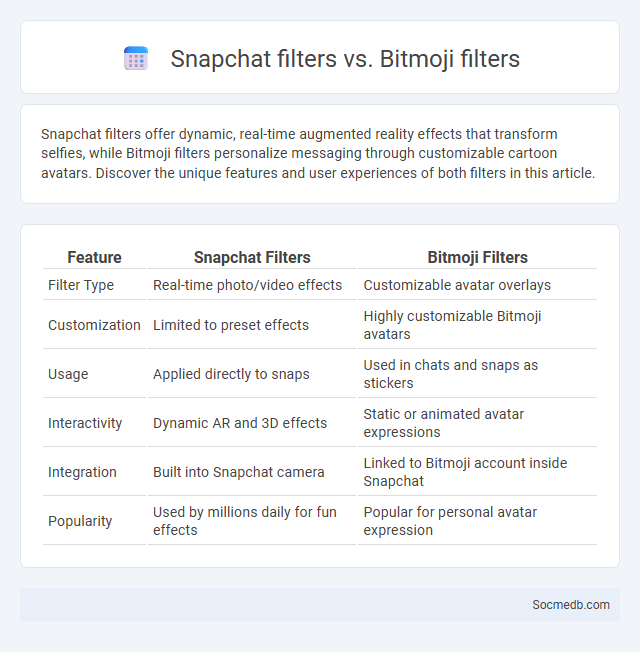
Photo illustration: Snapchat filters vs Bitmoji filters
Snapchat filters offer dynamic, real-time augmented reality effects that transform selfies, while Bitmoji filters personalize messaging through customizable cartoon avatars. Discover the unique features and user experiences of both filters in this article.
Table of Comparison
| Feature | Snapchat Filters | Bitmoji Filters |
|---|---|---|
| Filter Type | Real-time photo/video effects | Customizable avatar overlays |
| Customization | Limited to preset effects | Highly customizable Bitmoji avatars |
| Usage | Applied directly to snaps | Used in chats and snaps as stickers |
| Interactivity | Dynamic AR and 3D effects | Static or animated avatar expressions |
| Integration | Built into Snapchat camera | Linked to Bitmoji account inside Snapchat |
| Popularity | Used by millions daily for fun effects | Popular for personal avatar expression |
Introduction to Digital Filters
Digital filters in social media platforms play a crucial role in enhancing user-generated content by modifying images and videos through algorithms that adjust color, brightness, and contrast. These filters utilize signal processing techniques to isolate and amplify desired features, enabling more engaging visual storytelling and personalized experiences. Understanding the fundamental operation of digital filters allows developers to create innovative effects that improve content quality and increase user interaction.
What Are Snapchat Filters?
Snapchat filters are augmented reality effects that enhance your photos and videos by adding animations, graphics, or visual alterations in real time. These filters use facial recognition technology to apply fun and interactive elements like dog ears, flower crowns, or mood-based color tones directly to your selfies. Your use of Snapchat filters can make sharing moments more engaging and creatively expressive on social media platforms.
Features of Snapchat Filters
Snapchat filters offer a variety of augmented reality features that enhance your photos and videos with interactive effects such as face alteration, background changes, and animated graphics. These filters leverage facial recognition technology to apply real-time modifications, including beautification, facial expressions, and themed overlays that respond to your movements. Popular for engaging, personalized content, Snapchat filters also support geofilters and customizable options, making your social media stories more creative and shareable.
Understanding Bitmoji Filters
Bitmoji filters personalize your social media experience by integrating custom avatars into photos and videos, enhancing communication with expressive visuals. These filters use facial recognition technology and augmented reality to adapt your Bitmoji's appearance in real time, reflecting emotions or themes in your content. Mastering Bitmoji filters boosts engagement by making your posts and stories more relatable and visually appealing to your audience.
Unique Aspects of Bitmoji Filters
Bitmoji filters stand out in social media by allowing users to create personalized avatars that reflect their unique identity, enhancing engagement through customized visual storytelling. These filters integrate seamlessly with popular platforms like Snapchat, providing interactive and expressive features that traditional filters lack. Your social media interactions are enriched as Bitmoji filters bring a playful and individualized touch to digital communication.
General Filters: Definition & Types
General filters in social media platforms refer to algorithms or settings designed to sort, prioritize, or restrict content visibility based on user preferences, behavior, or platform policies. Common types include content filters that block inappropriate or sensitive material, engagement filters prioritizing posts with higher interaction, and chronological filters that display posts in the order they were published. These filters significantly influence user experience and content reach by tailoring feeds to individual needs and regulatory standards.
Key Differences Between Snapchat and Bitmoji Filters
Snapchat filters utilize augmented reality to overlay animations and effects directly onto your photos and videos, enhancing real-time interactions with dynamic visuals such as facial recognition animations and background changes. Bitmoji filters, on the other hand, personalize your digital avatar by integrating your customized Bitmoji character into various scenes, expressions, and stickers, providing a unique and personalized way to communicate emotions and messages. Understanding these key differences ensures you leverage Snapchat's immersive AR experiences while using Bitmoji filters for tailored, expressive avatar enhancements.
Pros and Cons of Each Filter Type
Photo filters on social media platforms such as Instagram and Snapchat enhance Your images by adjusting color tones, brightness, or adding effects like vintage or black and white, making content more visually appealing and engaging. However, while filters can improve aesthetics and boost user interaction, they may also create unrealistic beauty standards, reduce authenticity, and cause distortion in perception. Choosing between subtle color correction filters, artistic overlays, or face-altering enhancements requires balancing creative expression with genuine representation to maintain trust and relatability with Your audience.
User Experience: Personalization and Engagement
Social media platforms enhance user experience through advanced personalization algorithms that tailor content based on your interests, interactions, and browsing behavior. These algorithms increase engagement by delivering relevant posts, targeted ads, and customized recommendations, fostering a deeper connection with the platform. Optimizing content for individual preferences not only keeps you more engaged but also improves overall satisfaction and retention rates.
Choosing the Right Filter: Which One Suits You?
Choosing the right social media filter depends on your personal style, the mood you want to convey, and the platform's audience preferences. Vibrant filters like Instagram's Clarendon enhance colors for energetic, eye-catching posts, while subtle filters such as VSCO's A6 offer a natural, polished look suited for professional or lifestyle content. Understanding filter impacts on image tone and engagement can boost your social media presence and accurately reflect your brand or personality.
 socmedb.com
socmedb.com